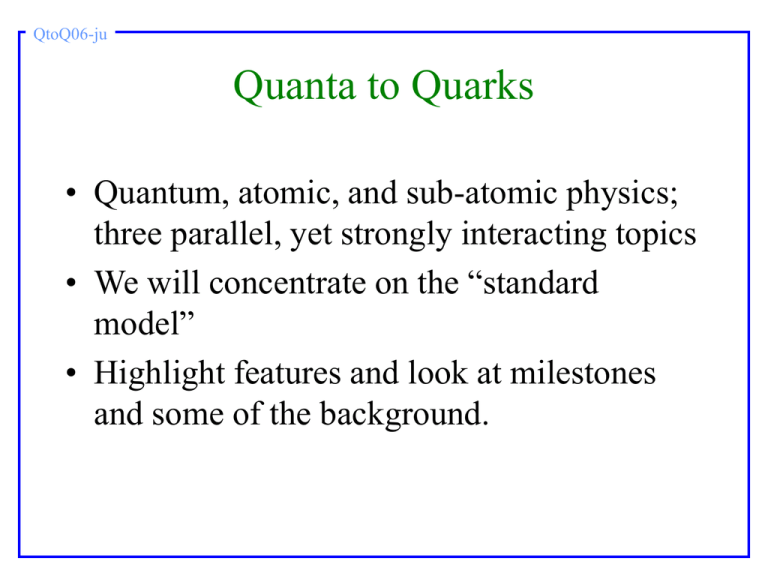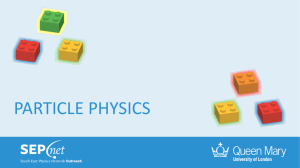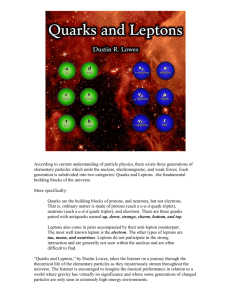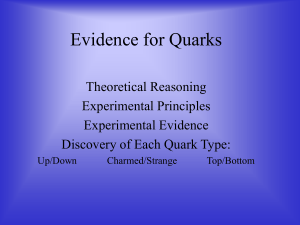Quanta to Quarks
advertisement

QtoQ06-ju Quanta to Quarks • Quantum, atomic, and sub-atomic physics; three parallel, yet strongly interacting topics • We will concentrate on the “standard model” • Highlight features and look at milestones and some of the background. QtoQ06-ju Quanta to Quarks – Nuclear path 1 • • • • • • Becquerel 1896 Rutherford 1911 Pauli 1930 Chadwick 1932 Heisenberg 1932 Hahn and Strassman 1938 radiation atom neutrino neutron Nucleus = n and p fission Nuclei and nucleons probe nucleus QtoQ06-ju Rutherford scattering 6 MeV alpha Closest distance for head–on approach QtoQ06-ju Detectors for scattering of electrons by protons and neutrons. Results consistent with nucleons having a substructure = quarks QtoQ06-ju Chadwick detection of the neutron Note:- charged particles not detected between beryllium and paraffin so photon or something else QtoQ06-ju Chadwick detection of the neutron Lead plate Note:- charged particles not detected between beryllium and paraffin so photon or something else… Radiation not stopped by inserted lead plate, so must be another neutral particle QtoQ06-ju Nucleus:- Z protons (atomic number) N neutrons Total A=Z+N (mass number) nucleons Number of protons Z Heisenberg model of nucleus:made up of protons and neutrons Number of neutrons N QtoQ06-ju protons Various decay modes of nucleus Beta minus decay X(A,Z) => Y(A,Z+1) + e- + n Beta plus decay X(A,Z) => Y(A,Z-1) + e+ + n Alpha decay X(A,Z) => Y(A-4,Z-2) +a neutrons QtoQ06-ju Alpha decay is a two body decay Alpha decay-1 Both the alpha and the recoil nucleus have the same momentum in opposite directions. The alphas always get the same proportion of the available energy, Q Qmd Ea md ma And hence have the same range in matter QtoQ06-ju Beta decay In beta decay the electrons have a range of energies even though the total energy available is the same. Pauli proposed that there is a third, undetected (hence neutral), particle which shares the energy and balances the momentum. Energy spectrum of electron The maximum electron energy is nearly the total available and so the third particle must have a very low mass. Beta decay QtoQ06-ju Quanta to Quarks – Nuclear path 2 • Powell 1947 – pi => mu => electron pion decay observed • Strange particles • Anti-particle – baryons • Reines - neutrino detected 1947-1950 1955 1956 Too many particles for all to be fundamental QtoQ06-ju Quanta to Quarks – Nuclear path 3 • • • • • Gell-Mann/Zweig 1964 Weinberg/Salam 1967 Glashow 1970 Richter/Ting J/y 1974 Perl 1975 Quark model electroweak charm in theory charm observed tau observed Standard Model emerges QtoQ06-ju Quanta to Quarks – Nuclear path 4 • Lederman U 1977 • Rubbia 1983 • CDF 1995 bottom observed W’s and Z0 top observed 1991-1992 Evidence indicates that there are only three generations of leptons from study of Z0. QtoQ06-ju Inward bound • • • • • • object and size grain, 1 mm virus, 100 nm atom, 100 pm nucleus, 10 fm nucleon, 1 fm quark, <1 am 1 am = 10-18 m QtoQ06-ju Inward Bound bound Inward • • • • • • object and size grain, 1 mm virus, 100 nm atom, 100 pm nucleus, 10 fm nucleon, 1 fm quark, <1 am From DESY site QtoQ06-ju How can we examine small objects ? By the light or particles they emit or reflect For very small objects the wavelength of the light or particle plays an important role QtoQ06-ju Scattering – wavelength dependence Diffraction of waves Note that spread of pattern depends on l/a : For l < a pattern depends on structure of object. For l > a pattern independent of structure of object QtoQ06-ju Particle diffraction Similar diffraction behaviour is observed for scattering of electrons, neutrons by nuclei and crystals etc. Wavelength of particle given by the de Broglie relationship:- h hc l 2 2 4 p ET m c Eg. A 1GeV electron has a wavelength (1.23 fm) about the same as the diameter of a nucleon. ( note:- for ET >> mc2 , l = l photon with same ET ) QtoQ06-ju Accelerator -1 CERN LEP e+eUp to~ 200GeV+200GeV LHC Pp 8Tev+8Tev 8.6 km diameter CERN photo QtoQ06-ju Accelerator -2 CERN LEP LHC Tunnel Beam pipes etc under construction CERN photo QtoQ06-ju Detectors - ATLAS at CERN physicist CERN photo QtoQ06-ju Visualization of particles tracks - 1 QtoQ06-ju The standard model • The standard model describes the universe in terms of a set of different kinds of particles and the interactions between them. • 12 particles (and their 12 antiparticles) – 6 leptons and their 6 antileptons – 6 quarks and their 6 antiquarks • 4 interaction forces:– gravity, electromagnetic, – weak, fundamental strong QtoQ06-ju the leptons – charge and mass MeV/c2 m/mproton -e 0.511 0.0055 ne 0 ~0 mu-minus m -e 105.66 mu-neutrino nm 0 0 tau-minus t -e 1777 tau-neutrino nt 0 ~0 symbol charge electron e- electron neutrino name 0.1126 1.894 QtoQ06-ju anti-leptons- charge and mass name symbol charge e-plus or positron e+ +e electron antineutrino ne 0 mu-plus m+ +e mu antineutrino nm 0 tau-plus t+ +e tau antineutrino nt 0 mass MeV/c2 m/mproton 0.511 0.0055 ~0 105.66 0.1126 ~0 1777 ~0 1.894 QtoQ06-ju Classification of particles – particles/anti particles Origin:- particles of exactly the same mass but opposite charge Later found to have other quantum numbers with opposite values Symbol:- either the electric charge as a superscript eg: p- and p+, e- and e+ or particle P anti-particle P (often said as P-bar) Neutral particles/anti-particles:some are the same (Majorana) eg p0 and some are different (Dirac) eg neutron, neutrino QtoQ06-ju The first anti-particles:- positrons, 1932 - Anderson 63 MeV positron upwards emerges with 23 MeV) 3 electrons (bend to left) and 3 positrons ( bend to right) QtoQ06-ju lepton numbers lepton number lepton le lm lt anti-lepton number le lm lt electron e- 1 0 0 -1 0 0 electron neutrino ne 1 0 0 -1 0 0 mu m 0 1 0 0 -1 0 mu-neutrino nm 0 1 0 0 -1 0 tau t 0 0 1 0 0 -1 tau-neutrino nt 0 0 1 0 0 -1 QtoQ06-ju Decay p+ => m+ => e+ m+ => nm + e+ + n e p+ => m+ + nm Note lepton numbers are conserved QtoQ06-ju quarks – charge and mass name symbol charge e mass MeV/c2 m/mproton down d -1/3 ~3 up u +2/3 ~6 strange s -1/3 100 0.1 charm c +2/3 1250 1.3 bottom b -1/3 4500 4.8 top t +2/3 175000 187 QtoQ06-ju q = +2e/3 q = -e/3 Quark picture 1983 according to Frank Close “Cosmic Onion” Heinemann Educational Books 1983 Top-quark found 1995 QtoQ06-ju Anti-quark - charge and mass name symbol charge e mass MeV/c2 m/mproton anti- down d -1/3 ~3 anti-up u +2/3 ~6 anti-strange s -1/3 100 0.1 anti-charm c +2/3 1250 1.3 anti-bottom b -1/3 4500 4.8 anti-top t +2/3 175000 187 QtoQ06-ju quarks – flavour numbers quark flavour numbers qd qu q s qc qb qt quark anti-quark flavour numbers q d qu qs qc qb qt down d 1 0 0 0 0 0 -1 0 0 0 0 0 up u 0 1 0 0 0 0 0 -1 0 0 0 0 strange s 0 0 -1 0 0 0 0 0 1 0 0 0 charm c 0 0 0 1 0 0 0 0 0 -1 0 0 bottom b 0 0 0 0 -1 0 0 0 0 0 1 0 top t 0 0 0 0 0 1 0 0 0 0 0 -1 QtoQ06-ju leptons and quarks - masses p Generations 1 2 3 QtoQ06-ju Fundamental forces force exchange boson "charge" range mass m/mp how many different kinds? gravity graviton mass infinite zero one electromagnetic photon electric infinite zero one three eight weak Fundamental strong W+ WZ0 weak 1 am 85.7 85.7 97.2 gluon colour infinite zero QtoQ06-ju forces acting between particles gravity weak strong y electromagnetic y charged leptons y neutral leptons y y n n quarks y y y y photons y n y n Z0 y y n n W+, W- y y y n gluons y n n y n QtoQ06-ju Conservation laws - 1 The following quantities are conserved in all interactions Ie:- the total before must be the same as the total afterwards • • • • Charge Energy Linear momentum Angular momentum QtoQ06-ju Conservation laws - 2 The following quantities are conserved in interactions as indicated:- S strong; E electromagnetic; W weak • • • • S Baryon number y Lepton flavour numbers y Quark flavour numbers y Colour y E y y y n/a W y y n n/a QtoQ06-ju Classification of particles: photons, leptons, mesons and baryons • Originally described mass. – – – – Photons Leptons Mesons Baryons no mass light medium heavy 0.5 MeV/c2 100-500 MeV/c2 > 900 MeV/c2 Still useful:turns out that this also describes structure and quark content. QtoQ06-ju Classification of particles – baryons and mesons and hadrons hadrons Baryons three quarks or three anti-quarks (anti baryons) Contain quarks Mesons a quark and an anti-quark QtoQ06-ju Classification of particles – baryons and mesons and hadrons hadrons Baryons Mesons valence quarks three quarks or three anti-quarks (anti baryons) gluons and sea quarks a quark and an anti-quark QtoQ06-ju Baryons:- proton and the neutron d the proton uud + sea quarks and gluons u u the neutron udd + sea quarks and gluons d d u QtoQ06-ju mesons:- the pion family p+ p0 p- u:d-bar u:u-bar d:d-bar u-bar:d QtoQ06-ju “colour - 1” Chromodynamics :- theory of the strong interaction, colour plays the same role as charge in electrodynamics. Need three colours, but hadrons have to be colourless Use red, green and blue (parallel to TV and photo and print) Anti-colours = white – colour ; cyan, magenta and yellow Gluons have a colour and an anti colour QtoQ06-ju “colour - 2” Quarks have colour, anti-quarks have anti-colour Baryons:- one (valence) quark of each colour (anti-baryons have three anti-colours) Mesons:- quark(colour)+anti-quark(anti-colour) Leptons, photons, W’s, Z0 do not have a colour QtoQ06-ju Classification of particles - generations First generation: Second generation: Third generation: leptons quarks ne e nm m u d c s nt t t b The upper member of each doublet is more positive QtoQ06-ju Classification of particles – fermions and bosons Fermions obey the Pauli exclusion principle:“two particles with the same quantum numbers can not occupy the same quantum state” Bosons don’t:“any number of identical bosons can occupy the same quantum state” Another way of saying this is:“Fermions follow Fermi/dirac statistics, bosons follow Bose/Einstein statistics” QtoQ06-ju Classification of particles – fermions and bosons Fermions:- leptons, quarks, neutron, proton and other baryons Bosons:- photons, gluons, W’s and Z0 mesons A nucleus can be either depending on its spin. QtoQ06-ju Classification of particles – fermions and bosons Fermions have half integral spin:- 1/2, 3/2, 5/2, 7/2 ….. Bosons have integral spin:- 0, 1, 2, 3 …. Spin magnitude and its orientation are quantum numbers, as are the allowed projections onto a preferred direction. Eg spin 3/2 : spin 2: -3/2, -1/2, +1/2, +3/2 -2, -1, 0, +1, +2 Are two different quantum states +1/2 -1/2 QtoQ06-ju Standard model and Nuclear Physics The nucleons remain as individual particles in the quantum well formed by the other nucleons in the nucleus Alpha, gamma decays, fission and fusion are reactions at the nuclear level. They are the result of nucleon to nucleon interactions via the “strong nuclear force” Beta decay is an interaction at the quark level QtoQ06-ju Standard model and Nuclear Physics The "strong nuclear force" is an exchange force mediated by (mostly) pi-mesons:- p+ (u d ), p- (u d), p0 ( mix of u u and d d ) The "strong nuclear force" is like the inter-molecular Van derWaals force, which is the result of the adding the electromagnetic forces, from the component electrons and nuclei, outside the neutral molecule. QtoQ06-ju alpha decay – quantum tunneling Nparent (Z,A) => Ndaughter(Z-2, A-4) + a + Q Ea Qmd md ma -log(t1/2) Geiger–Nuttal rule:large Z, low Ea = long half-life Gamow-Condon and Gurney prediction based on alpha tunneling . Z Ea QtoQ06-ju alpha decay – barrier penetration Alpha pre-formed in the nucleus electrical potential of alpha in field of daughter nucleus energy Energy of emitted alpha free bound alpha tunnels through potential barrier – a quantum effect radial distance QtoQ06-ju beta decay – nuclear and nucleon level Nuclear level Beta minus decay N*(A, Z) => N(A, Z+1) + e- + n e Beta plus decay N*(A, Z) => N(A, Z-1) + e+ + ne Nucleon level –within a nucleus n => p + e- + n e p => n + e+ + ne also for free neutron QtoQ06-ju beta decay – quark level u => d + W+ b+ + ne d u u W+ d u d b+ ne QtoQ06-ju beta decay – quark level u => d + W+ b+ + ne d u u W+ Quark flavour changed d u d b+ ne lepton/antilepton pair created The END not really, but I’ll stop here anyway QtoQ06-ju Exchange potential – Yukawa model infinite range potential p(r) g m 0 : p r r short range radial distance r ger m 0 : p r r R mc R QtoQ06-ju Monte-Carlo simulation of nuclear decay 10 sided “dice” – “decay” on 1 and 2 Start with 100 “nuclei” number surviving after N throws 120 100 80 Series1 Series2 60 40 20 0 0 10 20 30 40 number of throws, N Dice thrown for each nucleus until get 1 or 2 then go to next nucleus




